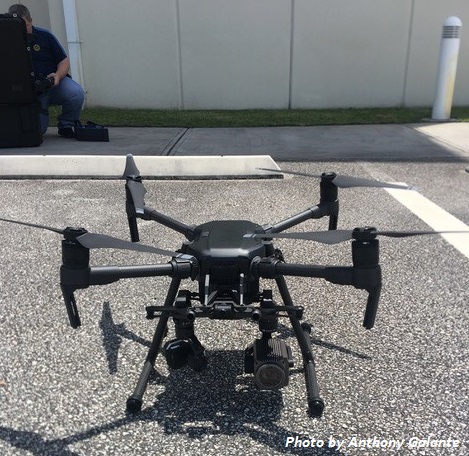By Anthony Galante, faculty member, Criminal Justice at American Military University
In the fall of 2019 at 7:30 a.m., the Daytona Beach (Florida) Police Department received a call from a front desk clerk at a local hotel. The clerk told police that there was a disturbance in one of the rooms.
When officers arrived, they heard a man inside the room yelling that he was going to kill his wife. He then proceeded to throw chairs from the fifth-floor balcony onto the pool deck below. Police interviewed several witnesses on scene who heard the suspect yell that he had a grenade. One witness claimed he saw the grenade in the man’s hand.
An officer was able to contact the suspect via the hotel landline phone. During the conversation the officer could hear the suspect yelling “who wants to die and be ripped to shreds?” The suspect told the officer that he had a grenade in his pocket and he would slaughter the officers in the hallway.
Based on this information, police evacuated the hotel for everyone’s safety. As the hotel was being evacuated, police remained in continuous communication with the threatening subject. In addition, all pedestrian and vehicle traffic was stopped around the hotel with the cooperation of multiple agencies.
Due to the unique elements of the dynamic incident, SWAT was requested to respond along with the hostage negotiation team (HNT). In addition, the department’s unmanned aircraft system (UAS) unit, which I belong to, went to the scene.
Establishing Scene Security
SWAT arrived and took up tactical positions around the room in the event the subject tried to leave. A sniper team was deployed as part of the SWAT element, but because of the configuration of the room and balcony, they had difficulty getting a good vantage point from which to see into the room. All the rooms in the hotel were angled at 45 degrees so each one had a beach-front view. But the angle and the height of the room made it difficult to see the suspect.
When the DBPD UAS unit arrived we noticed heavy air traffic in the area. There were private single-engine trainer aircraft, local tour helicopters, and small planes towing banners flying up and down the beach below 800 feet and within two tenths of a mile of the hotel. These planes were in extreme danger in the event of an explosion.
[Related: Florida Police Agency Uses Drones to Assess Hurricane Damage]
The agency contacted Daytona Beach International Airport to inform officials there of the situation and request that air traffic controllers keep aircraft out of the immediate airspace. The tower honored the request and asked to be called when the incident was over so the airspace could reopen.
Deploying Drones to Improve Officers’ Line of Sight
The UAS unit deployed its DJI Matrice 210, which can stay aloft for 40 to 45 minutes, depending on which and how many payloads it carries.
For this mission, the team equipped the drone with a Zenmuse Z30 camera and the Zenmuse XT thermal camera. The Z30 camera has great zoom capability. That enabled the operators to keep the UAS at a safe distance from the hotel while still being able to see the suspect. The operators could see into the suspect’s room through the balcony sliding glass door and capture clear images with the Z30 camera.
Drone Footage Identifies Grenade in Suspect’s Hand
Members of the UAS unit saw that the suspect was talking on the phone with the HNT and also was holding a suspected grenade in his hand. They were able to zoom in on the grenade and see that its bottom was hollowed out, suggesting it might be inert.
This evidence, including both pictures and videos captured by the UAS, was shared with the HNT, which swiftly contacted local area gun shops and learned that, in fact, the suspect had purchased an inert grenade a day earlier at one of the shops. The imagery was also shared with members of the bomb unit who also confirmed it was highly likely that the grenade was inert.
Because of this new information, officers on scene were comfortable that the grenade was inert. However, they remained vigilant about the possibility that the suspect may have had other weapons in the room.
Capturing the Suspect
Throughout the event, the suspect regularly talked to and acted out toward the UAS. This was important for the police, who knew that they could maneuver the UAS closer to the balcony if they needed to distract him. That would allow the SWAT team to enter the suspect’s room. However, that wasn’t needed.
After nearly six long hours of talking to the suspect, he finally agreed to leave the room for a bottle of soda. Shortly after 1 p.m. he left the room and SWAT personnel safely took him into custody. The suspect was taken to the local hospital for medical clearance and then to the local branch jail, where he was charged with multiple criminal acts.
Drone Credited with Saving Suspect’s Life
During the debrief, one SWAT officer stated, “If it weren’t for the drone seeing that it was a dud, there was a very high possibility that [the suspect] would have been smoked [shot] when he came out with the grenade…The drone definitely saved his life.”
This situation ended successfully because of the great teamwork by all agencies involved. The role of the UAS unit and the deployment of a drone provided officers with a bird’s-eye view of the developing situation, which proved critical for mission success.

